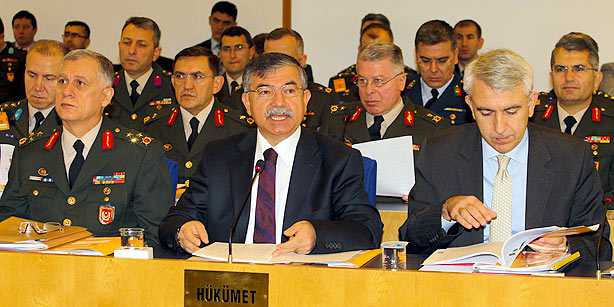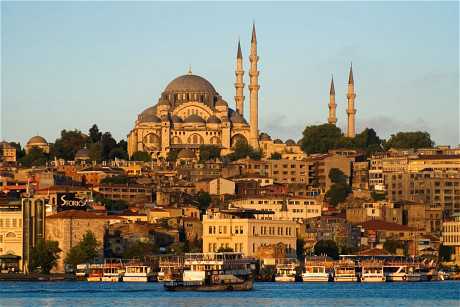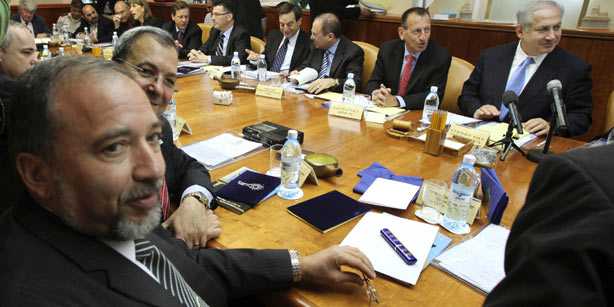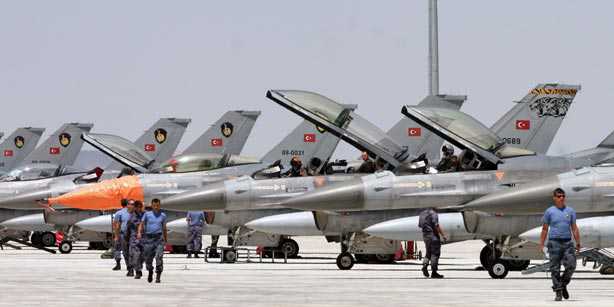Turkey’s armoured vehicle industry is flourishing at a time when large parts of the sector in other countries are suffering cutbacks and a lack of newbuild orders. Christopher F Foss explores Turkey’s success
The Turkish Land Forces Command (TLFC) survived for many years on a diet of mostly surplus US Army armoured fighting vehicles (AFVs), but that situation has now been turned on its head.
Turkey not only carries out extensive upgrade and repair of those legacy vehicles, but also designs, develops and manufactures a wide range of AFVs.
This has been supported by a number of technology transfers, industry offsets and a strong ‘buy Turkish’ policy. However, significant quantities of vehicles have also been exported to African, Asian and Middle Eastern users. Uncommonly for just one country, there are at least three competing Turkish manufacturers in the 6×6 and 8×8 markets. Sales, however, remain healthy locally and abroad.
Turkey has built up substantial experience working with legacy main battle tanks (MBTs) – upgrading M48s and M60s at TLFC and private facilities – to the extent that it has embarked on an indigenous MBT project. The bulk of the TLFC fleet consists of older Leopard 1, M48 and M60 tanks, all armed with 105 mm guns. Turkey, however, also fields 298 more modern ex-German Army Leopard 2 MBTs and 170 upgraded M60A3s armed with 120 mm smoothbore guns.
Under the latest upgrade 170 M60A3 MBTs have been transformed to the enhanced M60T configuration by the 2nd Maintenance Centre Command at Kayseri with Israel Military Industries (IMI) as the prime contractor. Modifications include improvements in protection (now featuring explosive reactive armour), mobility and firepower. The latter includes installation of a new computerised fire-control system (FCS) and a 120 mm smoothbore gun.
A total of 162 Leopard 1 MBTs have also been upgraded with the locally developed Aselsan Volkan FCS that increases the gun’s first-round hit probability, day and night.
All of this work helped to launch the Altay project to build a new MBT locally, at a time when there are virtually no other new MBTs in development or build around the world.
Otokar was selected as prime contractor for the Altay project by the Turkish Defence Industries Undersecretariat (SSM) in August 2008, working closely with South Korea’s Hyundai Rotem, which lent its expertise on the K1/K1A1 and K2 MBTs. A number of other Turkish companies will also be involved in the project, including MKEK for the 120 mm gun and ammunition and Roketsan for elements of the armour system.
Altay Phase I officially started on 1 February 2009 and ran for 15 months, covering system requirement analysis and concept work, leading into a three-year Phase II. A third and final phase will then see the construction of five prototype Altays for trials ahead of a production run that should see a total of 250 vehicles roll off the line.
Altay has an essentially conventional rear-engined layout. The turret and fighting compartment are in the middle of the vehicle, while the driver is located at the front right. The vehicle will have a crew of four and be armed with an L/55 120 mm smoothbore gun targeted through a digital FCS developed by Aselsan. In typical MBT fashion, it will also be armed with a co-axial 7.62 mm machine gun (MG) and .50-calibre MG on the turret roof, along with banks of grenade launchers.
The EuroPowerPack driving the vehicle comprises a 1,500 bhp MTU 883 diesel, coupled to a Renk HSWL 295 automatic transmission and a cooling system.
Development and testing is estimated to take a total of 78.5 months (just over 6.5 years) and cost around USD500 million.
In just a few years Otokar has established itself as a leading Turkish contractor in the design, development and production of wheeled tactical vehicles and AFVs. As well as securing its place as prime on the Altay project, the company has built more than 25,000 wheeled tactical vehicles and light AFVs for the home and export markets; vehicles have been exported to over 20 countries globally.
The company has been manufacturing Land Rover 4×4 tactical vehicles under licence for the home and export markets for many years and components of this vehicle are used on some of its lighter AFVs.
The Akrep (Scorpion) light reconnaissance vehicle, for example, drew around 70 per cent of its automotive components from the Land Rover line. An APC version of the Akrep features an all-welded steel armour hull that provides protection in its basic version to STANAG 4569 Level 1. Production of the Akrep, however, is now complete and Otokar stopped actively marketing the vehicle in 2010.
Instead, its emphasis has switched to the Armoured Patrol Vehicle (APV), which is still based on the Land Rover LWB 110 chassis but has an armoured body that pushes the typical gross vehicle weight (GVW) up to 4.1 tonnes. It is powered by a four-cylinder diesel developing a relatively meagre 122 bhp, but nevertheless enables a maximum road speed of 125 km/h.
In basic troop-carrying configuration it typically has a crew of two and carries six dismounts, but Otokar has also developed a wide range of more specialised versions including ambulance, command post vehicle, internal security vehicle, police vehicle and a mobile workshop. The latter features a protected two-door cab at the front and workshop area at the rear, which provides space for tools and equipment. Otokar’s best-selling lighter AFV, however, is the 4×4 Cobra tactical wheeled armoured vehicle. This is a departure from the separate chassis, Land Rover-based vehicles, boasting an all-welded monocoque steel hull and engine and driveline from the widely deployed AM General HMMWV Expanded Capacity Vehicle (ECV).
In its basic personnel carrier role, Cobra has a crew of two and can carry 11 dismounts, one of whom normally operates a roof-mounted weapon station. The latter can support anything from a 7.62 mm or .50-calibre MG in a protected mount up to a 20 mm cannon or an anti-tank guided weapon system, although many users prefer to fit a remote weapon station and associated day/night sensors.
The baseline Cobra has a GVW of about 6.3 tonnes and there are numerous specialised versions including the Modular Armoured Reconnaissance/Surveillance Vehicle – fitted with additional communications equipment and a mast-mounted day/night sensor pod – and NBC reconnaissance variants. An amphibious version with two propellers has been produced for at least five export customers. The propeller is powered by an hydraulic take-off from the 190 bhp General Motors V-8 turbocharged diesel engine at the rear. Cobra has been built in large numbers for Turkey, as well as Algeria, Bahrain, Bangladesh, Georgia, Maldives, Nigeria, Saudi Arabia, Slovenia and the United Arab Emirates (UAE).
Otokar has also completed company trials of its Kaya mine-resistant troop carrier, based on the proven Mercedes-Benz UMIMOG U-5000 4×4 cross-country chassis.
Kaya is claimed to provide a high level of mine and ballistic protection for its two-person crew and up to 10 dismounts. The latter are provided with firing ports and various weapon stations can be mounted on the roof.
Otokar also offers a Kaya cargo variant with a two-person protected crew compartment at the front and flatbed cargo area for up to 4.5 tonnes of cargo at the rear.
Orders take off
The company also has a product range in the increasingly crowded 6×6 and 8×8 market, starting with the new 6×6 Arma launched in mid-2010, initially as a contender for the TLFC Special Purpose Tactical Wheeled Armoured Vehicle (SPTWAV) requirement, but also to contest export competitions.
It secured its first Arma order in December 2010, but Otokar has been secretive about the exact details of the contract and although some sources point to Bahrain as the launch customer, that has not been confirmed. Otherwise, all that is known is that it was worth USD10 million – so numbers are expected to be small – and the vehicles are to be delivered within 15 months.
Arma has a typical GVW of 18.5 tonnes and carries a crew of two and up to 10 dismounts depending on the type of weapon station installed on the roof. This can range from the usual small- to medium-calibre MGs up to a one or two-person turret armed with a medium-calibre cannon.
Standard equipment includes an air-conditioning system, powered steering on the front four wheels, independent suspension with hydrostruts for improved cross-country mobility, and a central tyre inflation system, while the usual range of situational awareness and protection options can also be fitted. With a little preparation it can be made fully amphibious, using a pair of rear propellers to swim at up to 8 km/h.
Otokar has recently completed its first 8×8 Arma variant for trials and developed a prototype 16-tonne 4×4 internal security vehicle that carries a crew of two and 11 dismounts.
Turkey has also developed experience with artillery systems and the TLFC facility at Arifye is building the 155 mm/52-calibre Firtina self-propelled gun (SPG), which is a development of the South Korean Samsung Techwin K9 Thunder.
Until the introduction of this system the most modern conventional SPGs used by the TLFC were the 50-year-old M52 and M44, which have been upgraded in Turkey in a number of key areas including a new MTU diesel engine and the installation of a 155 mm/39-calibre barrel.
The TLFC has also re-roled older vehicles as they have been replaced by new deliveries. For example, M48 MBTs have been modified to serve as specialised armoured recovery and engineer vehicles, while the ubiquitous M113 armoured personnel carrier has been converted for a wide range of air-defence, ambulance, command post and engineering roles.
Additionally, Turkish industry has carved out a niche building evolved versions of existing vehicles for its own requirements. As a case in point, two decades ago FNSS Savunma Sistemleri (owned 51 per cent by Nurol and 49 per cent by BAE Systems) beat off international competition to secure a position as prime contractor manufacturing an enhanced version of the US Armoured Infantry Fighting Vehicle (AIFV) for the TLFC. The deal steadily increased the Turkish workshare and led to substantial follow-on orders and further evolutions of the vehicles.
The first order was for 1,698 Turkish Infantry Fighting Vehicles (TIFVs) and the first of them rolled off the production line near Ankara in late 1991. By the end of the first production run, over 76 per cent of the vehicles were manufactured in Turkey.
The first order was for four baseline vehicles including: 650 AIFVs (with a one-person turret armed with 25 mm dual- feed cannon and 7.62 mm co-axial MG); 830 Advanced APCs (AAPCs – with cupola-mounted .50-calibre MG); 48 anti-tank vehicles (with twin TOW missile launchers); and 170 Armoured Mortar Carriers (with turntable 81 mm mortars). This was followed by a second TLFC contract for an additional 551 AAPCs, which were delivered between late 2001 and late 2004.
In the export market the vehicle is normally referred to as the Armoured Combat Vehicle – ACV-300 or ACV-350 – the suffix denoting the 6V-53T Detroit Diesel engine’s horsepower rating.
Since Turkey took the vehicle on, FNSS has made continuous design enhancements for different users. For example, the UAE ordered 136 ACV-350s in 1997, including 53 in Engineering Squad Vehicle (ENG) configurations, eight repair and recovery vehicles and 76 artillery support vehicles, which all featured modifications over the standard design.
All were fitted with an air-conditioning system; NBC protection; and a cupola armed with a .50-calibre MG that could be operated by the gunner while still seated seated in the vehicle.
Technology sharing
Turkey is not averse to extending technology sharing to its customers in turn, and in 2000 a Malaysian order followed for 211 ACV-300s in 10 configurations. Initial deliveries were made in 2002 under the designation Adnan, with the first 146 coming from the Turkish production line and the remainder assembled in Malaysia by DefTech.
Malaysia has since ordered ACV-Stretched (ACV-S) variants, which have an additional road wheel on either side, offering greater internal volume and payload and the uprated 350 bhp engine. These are to be fitted with the French TDA 120 mm recoiling mortar system, which retracts under armour when not required. The first customer for the ACV-S was understood to be Saudi Arabia, which received 10 Tactical Command Post Vehicles (TCPVs) in 2007. The vehicle is being marketed for a much wider range of roles and can be fitted with a variety of one- or two-person turrets armed with a 25 mm or 30 mm cannon. The ACV-S has been shown in the Middle East fitted with a whole turret taken from a Russian BMP-3 IFV. As this is armed with a 100 mm gun, 30 mm co-axial cannon and 7.62 mm coaxial MG, it offers significant firepower.
A basic tracked load carrier has been built and tested – featuring a rear flatbed capable of carrying up to six tonnes of cargo – but there are no known orders yet.
The company has recently expanded its portfolio into the congested and hotly contested wheeled AFV market with the development of the Pars family of 4×4, 6×6 and 8×8 vehicles. The largest version forms the basis of the AV8 selected by Malaysia to replace its fleet of 4×4 Condor and 6×6 SIBMAS vehicles.
Following the ACV model, a recently signed agreement will see FNSS jointly develop and manufacture the AV8 with Malaysia’s DefTech. A total of 257 will be supplied in 12 configurations, with the first vehicles shipped in parts from Turkey and assembled in Malaysia. The first vehicle is due to arrive in early 2012 and the main production run will take place from 2013 to 2017.
FNSS told that in mid-2010 the 8×8 Pars also successfully completed trials with unnamed Middle Eastern customers under difficult and demanding conditions, but no known orders have so far been placed.
Other successes in the region include a series of upgrades for M113 variants, centring on Detroit Diesel’s 350 bhp 6V53-T engine and a new Allison X200 transmission. Appliqué armour, spall liners, air conditioning and a chemical-detection unit are also fitted into the vehicle.
Although FNSS has not provided official confirmation, it is understood that Saudi Arabia placed an initial order for 300 upgraded vehicles, with work carried out in-country. Another order for more than 300 was secured in the second half of 2010.
The company has also branched out into engineering and support vehicles, and is under contract to build a total of 12 Amphibious Armoured Combat Earthmovers – one prototype and 11 production units – for the TLFC, with the prototype due for delivery in 2012.
The first of 52 new Mobile Amphibious Assault Bridges (MAABs) built by FNSS are currently undergoing company trials ahead of handover to the TLFC for its own testing. In total, four operational systems and one training MAAB will be delivered to the TLFC.
Each of the operational versions will comprise 12 units, each with its own waterjet propulsion system, enabling several MAAB units to be joined together to span rivers up to 150 m wide, or be used as tactical conditions dictate.
Another Turkish company, Nurol Makina Ve Sanayi, is involved in a similar field to FNSS’ Pars and is continuing to expand the roles of its 6×6 Ejder Armoured Wheeled Vehicle (AWV).
The first prototype Ejder was completed in early 2007 and used for extensive company trials. At the end of that year, Georgia obliged with a first order for 70 Ejders in baseline APC configuration. These were all delivered by mid-2009 and subsequently fitted with a remote weapon station in Georgia.
Ejder has a typical combat weight of around 18 tonnes and is powered by a Cummins diesel developing 402 bhp, driving all six wheels through an Allison six-speed automatic transmission. It features an automatic drivetrain management (ADM) system and powered steering, as well as independent suspension all round.
The baseline vehicle can ford to a depth of 1.9 m, but an amphibious version has been developed fitted with two rear waterjets capable of swimming the vehicle at up to 9 km/h.
In the APC configuration Ejder has a crew of three and typically carries 10 dismounts when fitted with a remote weapon station. Alternatively, a wide range of other turrets and weapon systems can be fitted including one- or two-person turrets armed with weapons up to a 30 mm cannon.
Easy reconfiguration
A standard CAN-BUS enables the vehicle to be rapidly reconfigured and eases future upgrades. Nurol Makina Ve Sanayi is marketing a complete family of 6×6 Ejder vehicles including ambulance, command and control, engineer, mortar carrier, reconnaissance, repair and recovery and weapons carrier versions, with hulls modified accordingly, and the company is also developing 4×4 and 8×8 versions sharing components wherever possible.
The company also manufactures NBC systems for a number of Turkish AFVs and provides turrets, MG cupolas and armour solutions to other contractors in Turkey.
Turkey’s BMC has supplied more than 4,000 wheeled vehicles for military applications. About 1,000 of these are tactical cross-country vehicles with the remainder being second-line logistic support vehicles.
The company has also upgraded and overhauled a total of 302 BTR-60 8×8 amphibious APCs supplied by Russia for the Turkish Gendarmarie General Command, using a more fuel-efficient diesel engine, which doubled the original BTR-60’s operating range to 1,000 km.
In March 2009 BMC won a competition to secure a EUR300 million (USD402 million) contract for 1,859 tactical and mine-resistant ambush-protected (MRAP)-type vehicles for the TLFC.
The deal included a number of 2.5-tonne and 5-tonne 4×4 and 10-tonne 6×6 cargo trucks, as well as 468 BMC 350-16 Z ‘Kirpi’ 4×4 MRAPs developed by BMC with Israel’s Hatehof.
The 15-tonne Kirpis are powered by a 350 bhp 8.9-litre Cummins diesel engine, coupled to a fully automatic transmission, which gives a maximum road speed of 100 km/h and a range of about 800 km. The TLFC vehicles are fitted with conventional leafspring suspension, but the vehicles can also incorporate independent or helical spring arrangements.
According to BMC, trials have proven that the welded-steel monocoque provides a high level of protection, but no more details are available. It can carry a three-person crew and 10 fully equipped troops seated on individual seats.
A protected weapon station on the roof is typically armed with a 7.62 mm or .50-calibre MG, but other weapons can be fitted. Other options include a central tyre-inflation system and runflat tyres, rear-view camera, automatic fire detection and suppression system and a winch.
BMC also showed off a 250-10 Z Weapon Carrier Vehicle – Multi-Purpose Armoured Vehicle (WCV-MPAV) for the first time in 2009, developed with an eye on the potential requirements of the TLFC.
Depending on the configuration, the 4×4 variant of the 250-10 Z can carry up to nine troops and be fitted with a similar range of options as its larger 350-16 Z sibling. This smaller vehicle is powered by a 245 bhp Cummins diesel coupled to a fully automatic transmission. It can reach 800 km on a single tank of fuel and accelerate to 115 km/h on the road.






